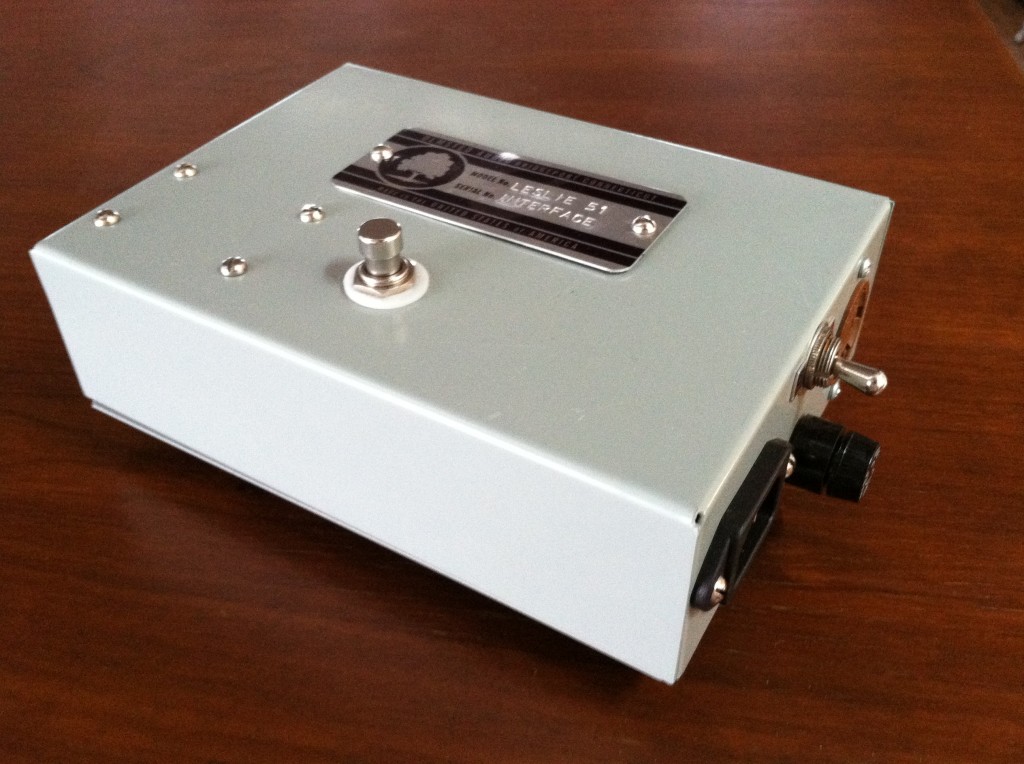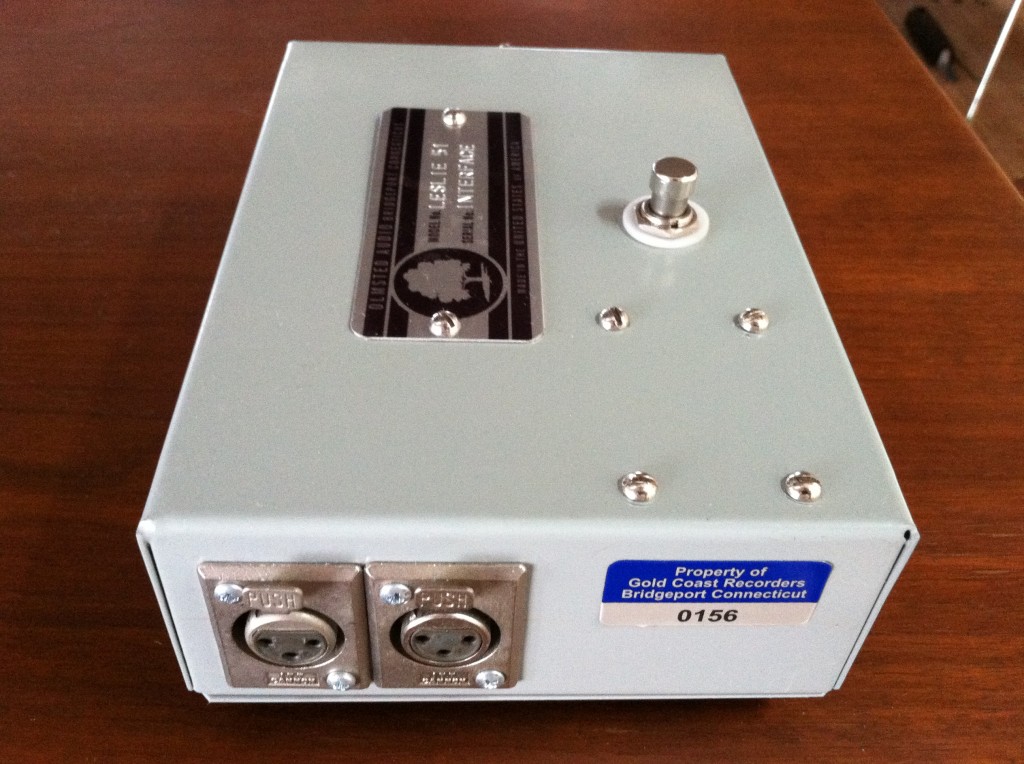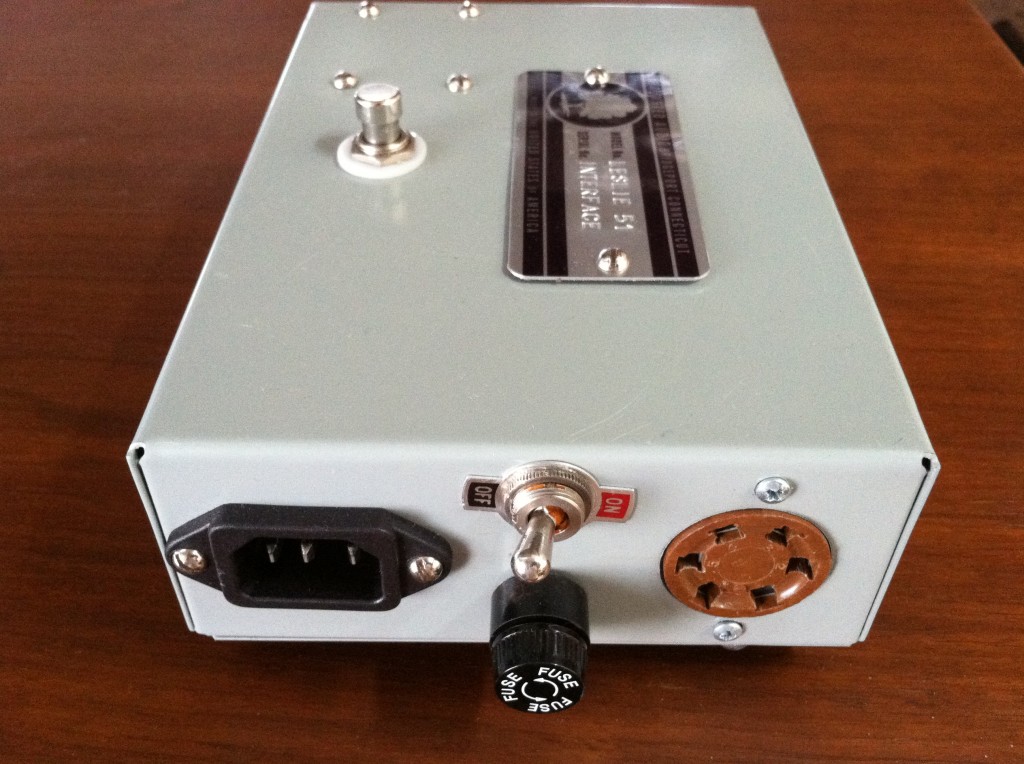 The Leslie Model 51 is a single-speed, large Leslie unit with 2 amps, a 15″ woofer, a rotating horn, and two stationary side-speakers. It sounds killer, and we wanted a way to get any audio signal off the board and into the unit. Here’s how we did it for about $100.
The Leslie Model 51 is a single-speed, large Leslie unit with 2 amps, a 15″ woofer, a rotating horn, and two stationary side-speakers. It sounds killer, and we wanted a way to get any audio signal off the board and into the unit. Here’s how we did it for about $100.
The Leslie 51 was originally designed to by driven and controlled by the Leslie model C2C preamplifier. Here’s the schematic for the C2C, taken from the original manual for the 51.
 The critical things to take away from this: the 51 has a 6-pin vacuum-tube type socket which supplies input power, ground, two unbalanced audio channels (600 ohm nominal) and a control pin to turn the leslie motors on and off. Pin one is Ground, 2 is control, 3 and 4 are 117 V AC, and 5 and 6 are the two audio channels. The motors are turned on simply by connecting pin 2 to pin 3. In our simplified control unit, this motor-control function is accomplished with the simple footswitch you see below.
The critical things to take away from this: the 51 has a 6-pin vacuum-tube type socket which supplies input power, ground, two unbalanced audio channels (600 ohm nominal) and a control pin to turn the leslie motors on and off. Pin one is Ground, 2 is control, 3 and 4 are 117 V AC, and 5 and 6 are the two audio channels. The motors are turned on simply by connecting pin 2 to pin 3. In our simplified control unit, this motor-control function is accomplished with the simple footswitch you see below.
 Balanced input jacks go into Jensen JT-11-FLCF series 600/600 transformers (AKA the cheap unshielded ones). These are used just to unbalance the lines going in, allowing the lines leading up to the interface to remain fully balanced.
Balanced input jacks go into Jensen JT-11-FLCF series 600/600 transformers (AKA the cheap unshielded ones). These are used just to unbalance the lines going in, allowing the lines leading up to the interface to remain fully balanced.
 The only other parts: an IEC receptacle, a fuse holder, power switch, and the 6-pin tube socket to mate with the Leslie cable. Enclosure is a steel Hammond. When I fired it up, it worked fine, but there was some hum and buzz when the motor was engaged. I figured that this was likely due to the dried-out 30 foot Leslie cable with 3 117V AC lines running parallel to the 2 unbalanced audio lines. Even at 600 ohms that will likely cause problems. I built a new 10-foot cable using Canare starquad for the audio lines and voila. I made the female cable end with a 6-pin tube socket, and the male cable end from the busted-off base of a… i think it was a 42 tube. Anyway. Problem solved. As beautiful as a Leslie sounds with an organ, it’s absolutely genius with guitar. This thing does require a pretty hot level to get it up to full volume, but it’s easily within reach of any piece of +4 balanced outboard gear. Even using it with the humble Guitar Pod sounds fantastic.
The only other parts: an IEC receptacle, a fuse holder, power switch, and the 6-pin tube socket to mate with the Leslie cable. Enclosure is a steel Hammond. When I fired it up, it worked fine, but there was some hum and buzz when the motor was engaged. I figured that this was likely due to the dried-out 30 foot Leslie cable with 3 117V AC lines running parallel to the 2 unbalanced audio lines. Even at 600 ohms that will likely cause problems. I built a new 10-foot cable using Canare starquad for the audio lines and voila. I made the female cable end with a 6-pin tube socket, and the male cable end from the busted-off base of a… i think it was a 42 tube. Anyway. Problem solved. As beautiful as a Leslie sounds with an organ, it’s absolutely genius with guitar. This thing does require a pretty hot level to get it up to full volume, but it’s easily within reach of any piece of +4 balanced outboard gear. Even using it with the humble Guitar Pod sounds fantastic.
5 replies on “Leslie Rotating-Speaker Interface Unit – UPDATED”
Do you know of an interface for guitar to leslie that would work with a leslie 147 or251
http://www.captain-foldback.com/Leslie_sub/combo_preamps.htm
I absolutely agree the Leslie is as good for guitar as for organ, but the sheer size makes it not something you want to haul around. If you’re on tour or otherwise playing out or if you have a B-3 in the house, you can rent, or have there a Leslie, but it’s a 122 or 145/147.
You want to use the other guy’s. He won’t take kindly to modding it, so you want a box that interfaces with it, or any other Leslie you may find. You want all the common Leslie interfaces then, which are the 6 pin and an 11 pin if I remember right.
Yes, there’s the Leslie combo preamp, but that’s a kluge for rock guitarists. Better would be a tube amp that can work as a preamp with a dummy load-a modified Champ, or the Canadian Garnet Herzog…or a THD Univalve-which also has the switches and connectors to run the Leslie.
You’d think someone would make one. The logical vendor in fact would be Andy Marshall of THD, but he isn’t going to do it, probably because it wasn’t his idea. Neither is Aspen Pittman, who has the tech chops of a rutabaga anyway. Maybe someone else will pick up on this idea.
a studio interface for the 122 leslie is findable on my website:
http://www.uneeda-audio.com/leslie
and a description of the hammond b/c3 (pre)amplifier with a circuit
description of the harmonic percussion circuit can be found at:
http://www.uneeda=audio.com/stuff
The studio interface is not going to run a guitar direct in. You want one unit that will take the guitar lead in in one end and drive the Les from the other.
Unfortunately, there are not that many guitarists that really want Leslie. It’s a great sound, but until someone does it AGAIN on a big hit or a guitar magazine poster boy track, no one is going to buy one.